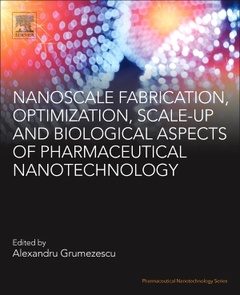Nanoscale Fabrication, Optimization, Scale-up and Biological Aspects of Pharmaceutical Nanotechnology Pharmaceutical Nanotechnology Series
Coordonnateur : Grumezescu Alexandru Mihai

Nanoscale Fabrication, Optimization, Scale-up and Biological Aspects of Pharmaceutical Nanotechnology focuses on the fabrication, optimization, scale-up and biological aspects of pharmaceutical nanotechnology. In particular, the following aspects of nanoparticle preparation methods are discussed: the need for less toxic reagents, simplification of the procedure to allow economic scale-up, and optimization to improve yield and entrapment efficiency. Written by a diverse range of international researchers, the chapters examine characterization and manufacturing of nanomaterials for pharmaceutical applications. Regulatory and policy aspects are also discussed.
This book is a valuable reference resource for researchers in both academia and the pharmaceutical industry who want to learn more about how nanomaterials can best be utilized.
1. Fabrication of polymeric core-shell nanostructures 2. Emulsification-diffusion method to obtain polymeric nanoparticles: two decades of research 3. Tools and Techniques for the optimized synthesis, reproducibility and scale up of desired nanostructures from plant derived material and their role in pharmaceutical properties 4. Scale up of biopharmaceuticals production 5. Physicochemical and morphological characterization of pharmaceutical nanocarriers and mathematical modelling of drug encapsulation/release mass transfer processes 6. Biopharmaceutics and pharmacokinetics of multifunctional nanoparticles 7. Technological delivery systems to improve biopharmaceutical properties 8. From physicochemically stable nanocarriers to targeted drug delivery: in-vivo pharmacokinetic, pharmacodynamic and biodistribution studies 9. Sterile dosage forms loaded nanosystems for parenteral, nasal, pulmonary and ocular administration 10. Quantitative Characterization of Targeted Nanoparticulate Formulations for Prediction of Clinical Efficacy 11. Analytical tools for reliable in vitro and in vivo performance testing of drug nanocrystals 12. Application of one-step affinity purification of drug-binding proteins with practical magnetic nanoparticles to drug discovery 13. Molecularly Imprinted Polymers as Separation Tools 14. Detection of DNA damage induced by nanomaterials 15. Pharmacological usage of an enzyme inhibitor – a selective inhibitor of 3-mercaptopyruvate sulfurtransferase reaction intermediate to control generation of polysulfide 16. Regulatory Consideration in Nanotechnology Based Drug Products
Pharmaceutical scientists, biomaterials scientists, toxicologists, biomedical engineers, medicinal chemists and postgraduate students specializing in the areas of nanomedicine, bionanomaterials and nanotechnology applications in healthcare.
- Shows how nanomanufacturing techniques can help to create more effective, cheaper pharmaceutical products
- Explores how nanofabrication techniques developed in the lab have been translated to commercial applications in recent years
- Explains safety and regulatory aspects of the use of nanomanufacturing processes in the pharmaceutical industry
Date de parution : 11-2017
Ouvrage de 696 p.
19x23.3 cm
Thèmes de Nanoscale Fabrication, Optimization, Scale-up and... :
Mots-clés :
(trans)dermal delivery; 3-mercaptopyruvate sulfurtransferase; Abbreviated new drug application; Aceclofenac; Affinity nanoparticles; Analytical tools; Antibody conjugation; Antioxidant action; Applications; Avidity; Binary cyclodextrin complexes; Binding force; Bioactive compounds; Bioavailability; Biopharmaceutical properties; Bioreactor; Brain delivery; Cell harvesting; Centrifugation; Cereblon; Characteristics; Chromatography; Common technical document; Computer-optimization; Core-shell nanostructures; Critical quality attributes; Cysteine; DNA damage; Dermatopharmacokinetic method; Detection; Dissolution rate; Downstream processing; Drug delivery systems; Drug nanocarriers; Drug nanocrystals; Drug release; Drugs; Electrochemical techniques; Electrophoresis; Emulsification-diffusion method; Equilibrium; FG beads; Fabrication-methods; Fermentation; Food and Drug Administration; Formation mechanism; Hydrogen persulfide; In vitro; In vivo; In vivo characterization protocol; Inhibitor; Kinetics; Mathematical modeling; Membrane filtration; Microemulsions; Molecular targeting; Morphology; Multicomponent complexes; Nanocapsules; Nanocarriers; Nanomaterials; Nanoparticles; Nanospheres; Nanosystems; Natural-polymers; New drug application; Noncovalent binding affinity; Permeability; Pharmaceutical properties; Pharmacokinetic parameters; Physicochemical analysis; Physicochemical characterization; Plant derivatives; Polymeric nanoparticles; Polysulfide; Poor solubility; Process development; Protonanoparticles; Purification; Quality by design; Reaction mechanism; Reproducibility; Risperidone; SG beads; Scale up; Solid lipid nanoparticles; Solid self-microemulsifying drug delivery systems; Solubility; Specifications; Sterile dosage forms; Synthetic-polymers; Target isolation; Thalidomide; Tools; Visualization methods



